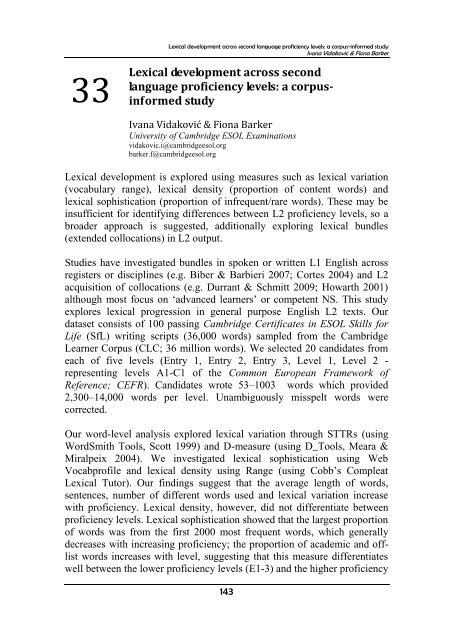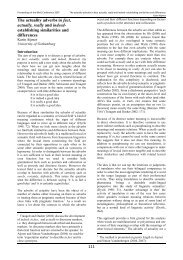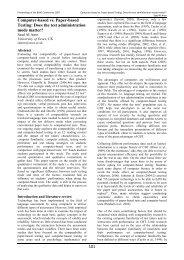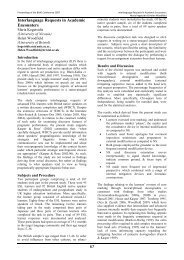Lexical development across second language proficiency levels
Lexical development across second language proficiency levels
Lexical development across second language proficiency levels
Create successful ePaper yourself
Turn your PDF publications into a flip-book with our unique Google optimized e-Paper software.
33<br />
<strong>Lexical</strong> <strong>development</strong> <strong>across</strong> <strong>second</strong> <strong>language</strong> <strong>proficiency</strong> <strong>levels</strong>: a corpus-informed study<br />
Ivana Vidakovic & Fiona Barker<br />
<strong>Lexical</strong> <strong>development</strong> <strong>across</strong> <strong>second</strong><br />
<strong>language</strong> <strong>proficiency</strong> <strong>levels</strong>: a corpusinformed<br />
study<br />
Ivana Vidaković & Fiona Barker<br />
University of Cambridge ESOL Examinations<br />
vidakovic.i@cambridgeesol.org<br />
barker.f@cambridgeesol.org<br />
<strong>Lexical</strong> <strong>development</strong> is explored using measures such as lexical variation<br />
(vocabulary range), lexical density (proportion of content words) and<br />
lexical sophistication (proportion of infrequent/rare words). These may be<br />
insufficient for identifying differences between L2 <strong>proficiency</strong> <strong>levels</strong>, so a<br />
broader approach is suggested, additionally exploring lexical bundles<br />
(extended collocations) in L2 output.<br />
Studies have investigated bundles in spoken or written L1 English <strong>across</strong><br />
registers or disciplines (e.g. Biber & Barbieri 2007; Cortes 2004) and L2<br />
acquisition of collocations (e.g. Durrant & Schmitt 2009; Howarth 2001)<br />
although most focus on ‘advanced learners’ or competent NS. This study<br />
explores lexical progression in general purpose English L2 texts. Our<br />
dataset consists of 100 passing Cambridge Certificates in ESOL Skills for<br />
Life (SfL) writing scripts (36,000 words) sampled from the Cambridge<br />
Learner Corpus (CLC; 36 million words). We selected 20 candidates from<br />
each of five <strong>levels</strong> (Entry 1, Entry 2, Entry 3, Level 1, Level 2 -<br />
representing <strong>levels</strong> A1-C1 of the Common European Framework of<br />
Reference; CEFR). Candidates wrote 53–1003 words which provided<br />
2,300–14,000 words per level. Unambiguously misspelt words were<br />
corrected.<br />
Our word-level analysis explored lexical variation through STTRs (using<br />
WordSmith Tools, Scott 1999) and D-measure (using D_Tools, Meara &<br />
Miralpeix 2004). We investigated lexical sophistication using Web<br />
Vocabprofile and lexical density using Range (using Cobb’s Compleat<br />
<strong>Lexical</strong> Tutor). Our findings suggest that the average length of words,<br />
sentences, number of different words used and lexical variation increase<br />
with <strong>proficiency</strong>. <strong>Lexical</strong> density, however, did not differentiate between<br />
<strong>proficiency</strong> <strong>levels</strong>. <strong>Lexical</strong> sophistication showed that the largest proportion<br />
of words was from the first 2000 most frequent words, which generally<br />
decreases with increasing <strong>proficiency</strong>; the proportion of academic and offlist<br />
words increases with level, suggesting that this measure differentiates<br />
well between the lower <strong>proficiency</strong> <strong>levels</strong> (E1-3) and the higher <strong>proficiency</strong><br />
143
Proceedings of the BAAL Annual Conference 2009<br />
Newcastle University<br />
<strong>levels</strong> (L1-2). Off-list words showed a progression from proper nouns and<br />
words referring to everyday objects at the lower <strong>levels</strong> to words denoting<br />
more complex abstract notions and activities at the higher <strong>levels</strong>.<br />
At the level of multi-word sequences, we identified and analysed recurrent<br />
4-word lexical bundles <strong>across</strong> <strong>levels</strong>, having calculated their normed<br />
frequency (using Biber & Barbieri 2007’s 40/million cut-off), and selected<br />
those produced by three or more writers. Lower <strong>proficiency</strong> learners (E1/2)<br />
used a limited set of bundles (6/27 types) mostly taken from the input. E3<br />
learners mostly relied on their own resources (23 types), which resulted in<br />
fewer re-used bundles. Higher <strong>proficiency</strong> learners (L1/2) used even fewer<br />
bundles from the task prompts but more overall (66/91 types), suggesting<br />
greater creativity; task prompt re-use was 63-26% of lexical bundle types<br />
from lower to higher <strong>levels</strong>.<br />
Following Biber & Barbieri (2007), Cortes (2004) and Nekrasova (2009),<br />
we functionally classified bundles into: referential (identifying an object or<br />
attribute); discourse (indicating discourse structure); stance (conveying<br />
attitudes and epistemic evaluations) and special conversational (expressing<br />
politeness, inquiry and report). The most frequent bundles overall were<br />
referential, the number and variety of which increased from E1 to L2.<br />
Discourse bundles were rarely used at lower <strong>levels</strong>; only at L1/2 did<br />
learners use them much more often. Stance and special conversational<br />
bundles exhibited a gradual increase in number and variety with<br />
<strong>proficiency</strong>. The analysis of functions of lexical bundles in L2 output<br />
provides insights into the <strong>development</strong> of discourse organisation and<br />
reveals that communicative need may inform their use. Whilst referential<br />
bundles dominate at all <strong>levels</strong>, other functions are increasingly used at<br />
higher <strong>levels</strong>. Stance and special conversational bundles are used more<br />
often than discourse bundles by lower <strong>proficiency</strong> learners which may<br />
indicate that they are required earlier, possibly for establishing an<br />
immediate connection with interactants. Discourse structuring bundles are<br />
the <strong>second</strong> most frequent category for higher <strong>proficiency</strong> learners, which<br />
could be due to learners’ increased <strong>proficiency</strong> and the need to structure<br />
more complex messages.<br />
Key factors behind L2 acquisition of lexical bundles could be a low degree<br />
of perceptual salience, since many bundles are incomplete structural units;<br />
structural or semantic complexity; or their specific discourse functions.<br />
Input frequency may also be important; this is one avenue for further<br />
research.<br />
144
<strong>Lexical</strong> <strong>development</strong> <strong>across</strong> <strong>second</strong> <strong>language</strong> <strong>proficiency</strong> <strong>levels</strong>: a corpus-informed study<br />
Ivana Vidakovic & Fiona Barker<br />
Overall, we suggest that lexis produced by learners clearly becomes more<br />
complex with every <strong>proficiency</strong> level. We found that enhanced frequency<br />
measures are informative in identifying vocabulary progression <strong>across</strong><br />
<strong>proficiency</strong> <strong>levels</strong>. The average length of words and sentences, the number<br />
of word tokens and types as well as lexical diversity and sophistication<br />
differentiated between <strong>levels</strong>, increasing in number and proportion with<br />
<strong>proficiency</strong>. WordSmith Tools and Compleat <strong>Lexical</strong> Tutor, and to a<br />
limited extent, D_Tools, were found to be useful software for investigating<br />
lexical progression. The frequency and functions of lexical bundles are also<br />
useful differentiators between <strong>language</strong> <strong>proficiency</strong> <strong>levels</strong>. Learning<br />
conventionalised word strings starts emerging after the lowest <strong>proficiency</strong><br />
level but becomes truly productive only at later stages of <strong>second</strong> <strong>language</strong><br />
acquisition which correspond to SfL <strong>levels</strong> L1/2 (B2/C1 on the CEFR).<br />
<strong>Lexical</strong> bundles are rarely used by the lowest <strong>proficiency</strong> SfL learners,<br />
which suggests that they rely on learning individual words rather than<br />
conventionalised multi-word sequences. Use of conventionalised strings<br />
starts developing from E2 level, but they are used more productively only<br />
at higher <strong>proficiency</strong> <strong>levels</strong>.<br />
This study combined qualitative and quantitative approaches to lexical<br />
progression in L2 general purpose writing. It has implications for the field<br />
of L2 acquisition, for <strong>language</strong> testers who can follow this methodology to<br />
strengthen the validity argument for writing tests, and also for teachers who<br />
could use this study to raise awareness of lexical <strong>development</strong>, especially<br />
of lexical bundles, which may help to focus preparatory work for general<br />
purpose <strong>language</strong> qualifications and suggest ways of analysing their<br />
students’ work.<br />
References<br />
Douglas Biber & Federica Barbieri. 2007. <strong>Lexical</strong> bundles in university<br />
spoken and written registers. In English for Specific Purposes vol 26<br />
3, pp263-286.<br />
Tom Cobb. 2009. Compleat <strong>Lexical</strong> Tutor. Version 6.2. Accessed<br />
04/11/09. http://www.lextutor.ca/<br />
Viviana Cortes. 2004. <strong>Lexical</strong> bundles in published and student<br />
disciplinary writing: Examples from history and biology. In English<br />
for Specific Purposes vol 23 4, pp397-423.<br />
145
Proceedings of the BAAL Annual Conference 2009<br />
Newcastle University<br />
Philip Durrant and Norbert Schmitt. 2009. To what extent do native and<br />
non-native writers make use of collocations? In IRAL vol 47, pp157-<br />
177.<br />
Peter Howarth. 2001. The Phraseology of Learner’s Academic Writing. In<br />
Anthony Paul Cowie (ed.) Phraseology: Theory, Analysis and<br />
Applications. Oxford University Press: Oxford, UK, pp162-186.<br />
Paul Meara and Imma Miralpeix. 2004. D_Tools. Version 2.0. Accessed<br />
04/11/09. http://www.lognostics.co.uk/tools/index.htm<br />
Tatiana Nekrasova. 2009. English L1 and L2 Speakers’ Knowledge of<br />
<strong>Lexical</strong> Bundles. In Language Learning vol 59 3, pp647-686.<br />
Mike Scott. 1999. WordSmith Tools. Version 3. Oxford University Press:<br />
Oxford, UK.<br />
146







